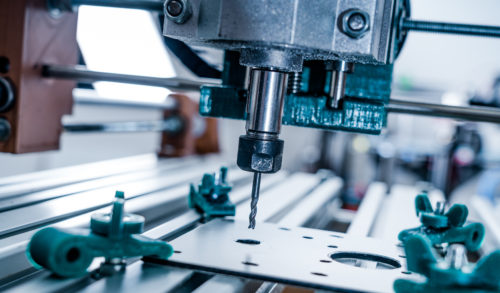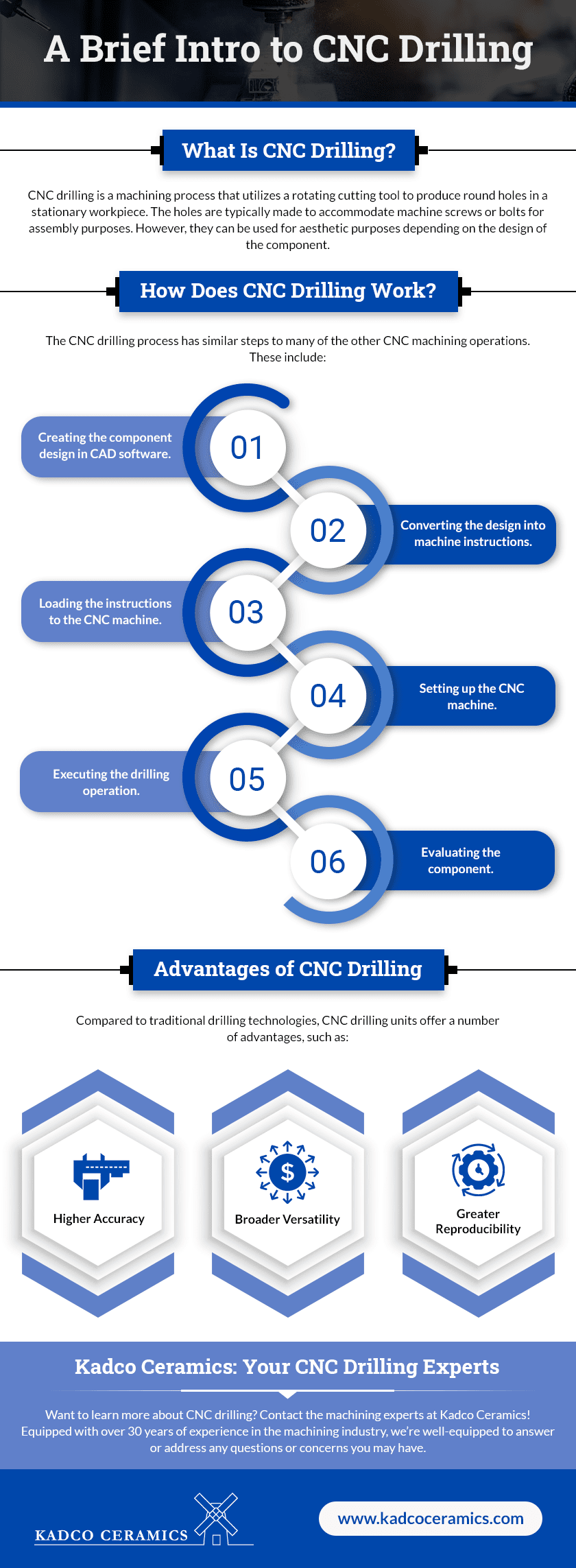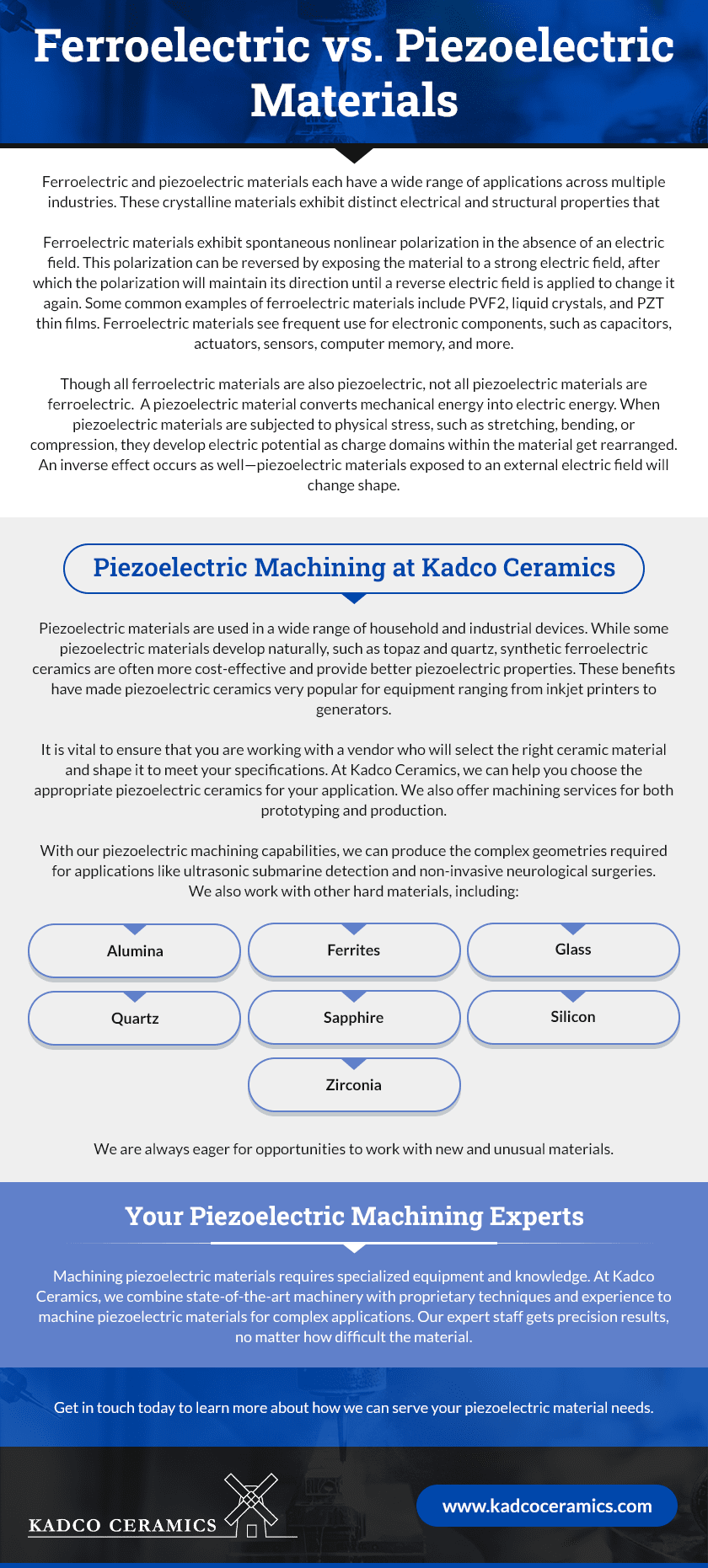A Brief Intro to CNC Drilling
Leave a CommentWhat Is CNC Drilling?
CNC drilling is a machining process that utilizes a rotating cutting tool to produce round holes in a stationary workpiece. The holes are typically made to accommodate machine screws or bolts for assembly purposes. However, they can be used for aesthetic purposes depending on the design of the component.
How Does CNC Drilling Work?
The CNC drilling process has similar steps to many of the other CNC machining operations. These include:
- Creating the component design in CAD software. The first step in producing a CNC drilled component is creating a digital design of it in CAD software.
- Converting the design into machine instructions. Once the component design is finalized, it needs to be converted into a language the CNC unit can understand. This step typically requires running the CAD design through CAM software to generate machine code.
- Loading the instructions to the CNC machine. When loaded to the CNC machine, the machine code controls how the CNC machine and tooling will move and operate throughout the drilling process.
- Setting up the CNC machine. Setting up the CNC machine generally involves installing the appropriate drill bit and securing the workpiece.
- Executing the drilling operation. Once the machine code is loaded and the machine is set up, the operator can initiate the drilling operation.
- Evaluating the component. After the drilling operation is finished, the operator evaluates the component for any errors or imperfections.
Advantages of CNC Drilling
Compared to traditional drilling technologies, CNC drilling units offer a number of advantages, such as:
- Higher accuracy. Drilling machines integrated with CNC technology can make holes that are accurate to t
 he original design file within very tight margins.
he original design file within very tight margins. - Broader versatility. CNC drilling units can be used for a wide range of materials, from metal to plastic to wood. Additionally, since they can accommodate multiple drill bits, they can be utilized to produce a variety of holes.
- Greater reproducibility. Since CNC drilling units are computer-controlled, they are lessprone to error. As a result, manufacturers can achieve high consistency throughout a batch and between batches.
Kadco Ceramics: Your CNC Drilling Experts
Want to learn more about CNC drilling? Contact the machining experts at Kadco Ceramics! Equipped with over 30 years of experience in the machining industry, we’re well-equipped to answer or address any questions or concerns you may have.
Ferroelectric vs. Piezoelectric Materials
Leave a CommentFerroelectric and piezoelectric materials each have a wide range of applications across multiple industries. These crystalline materials exhibit distinct electrical and structural properties that
Ferroelectric materials exhibit spontaneous nonlinear polarization in the absence of an electric field. This polarization can be reversed by exposing the material to a strong electric field, after which the polarization will maintain its direction until a reverse electric field is applied to change it again. Some common examples of ferroelectric materials include PVF2, liquid crystals, and PZT thin films. Ferroelectric materials see frequent use for electronic components, such as capacitors, actuators, sensors, computer memory, and more.
Though all ferroelectric materials are also piezoelectric, not all piezoelectric materials are ferroelectric. A piezoelectric material converts mechanical energy into electric energy. When piezoelectric materials are subjected to physical stress, such as stretching, bending, or compression, they develop electric potential as charge domains within the material get rearranged. An inverse effect occurs as well—piezoelectric materials exposed to an external electric field will change shape.
Piezoelectric Machining at Kadco Ceramics
Piezoelectric materials are used in a wide range of household and industrial devices. While some piezoelectric materials develop naturally, such as topaz and quartz, synthetic ferroelectric ceramics are often more cost-effective and provide better piezoelectric properties. These benefits have made piezoelectric ceramics very popular for equipment ranging from inkjet printers to generators.
It is vital to ensure that you are working with a vendor who will select the right ceramic material and shape it to meet your specifications. At Kadco Ceramics, we can help you choose the appropriate piezoelectric ceramics for your application. We also offer machining services for both prototyping and production.
With our piezoelectric machining capabilities, we can produce the complex geometries required for applications like ultrasonic submarine detection and non-invasive neurological surgeries. We also work with other hard materials, including:
- Alumina
- Ferrites
- Glass
- Quartz
- Sapphire
- Silicon
- Zirconia
We are always eager for opportunities to work with new and unusual materials.
Your Piezoelectric Machining Experts
Machining piezoelectric materials requires specialized equipment and knowledge. At Kadco Ceramics, we combine state-of-the-art machinery with proprietary techniques and experience to machine piezoelectric materials for complex applications. Our expert staff gets precision results, no matter how difficult the material.
Get in touch today to learn more about how we can serve your piezoelectric material needs.

 Thomas Registered Supplier
Thomas Registered Supplier

